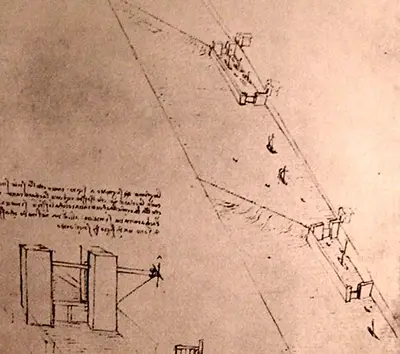Leonardo da Vinci (1452 - 1519), best known as one of, if not the greatest Renaissance artist and sculptor, was also a keen engineer, architect and inventor.
Throughout his lifetime he kept notebooks, containing sketches of his drawings, inventions and ideas.
Over 7000 of these sketches and notes have survived, all written in mirror script (writing is in opposite direction and individual letters reversed, best read in a mirror) and have been compiled into The ‘Codex Atlanticus’, which is currently in the care of the Biblioteca Ambrosiana in Milan.
The drawing was made whilst he was in service to The Duke of Milan, Ludovico Sforza, as the State’s consultant engineer, a post he held for twenty years.
One of the tasks he was given as ducal engineer was to connect the Naviglio and Martesana canals, through Milan’s internal waterways. To achieve this he constructed six new locks, the most notable of which was the San Marco lock in Milan. Da Vinci’s sketch shows a design for the San Marco lock and details his invention of a new gate system.
The lock system in common use at the time featured portcullis gates which required a tremendous amount of effort to operate. To open they had to be hauled up vertically, going against the force of gravity, and therefore usually required at least two men for the task.
Da Vinci’s simple but genius invention became known as the miter gate, so named because the two gates were at 45 degree angles, meeting each other at a point.
The sketch is full of information on the miter gate and the drawing is hugely detailed, showing vertical wooden planks with braces that form the miter and quoin posts, the floor underneath the gates constructed of brick, and holes in the wall into which the gates fold.
The gates operated on hinges, like doors, and when closed they formed a v-shape, pointing upstream. A huge advantage of these gates was that as well as being easier to open and close, when the pressure of the water hit them, it forced the two miters into each other, resulting in the gates also being self-sealing.
The pressure also prevents their being opened until water levels have equalised on both sides of the gates. The sketch also illustrates the flap-valve, already in common use, which is fitted into the gates to allow the water levels to be equalised.
This new lock design was one of Da Vinci’s inventions that was embraced almost immediately and even today most canals worldwide use these gates, including the huge locks on the great Panama and Suez Canals.


